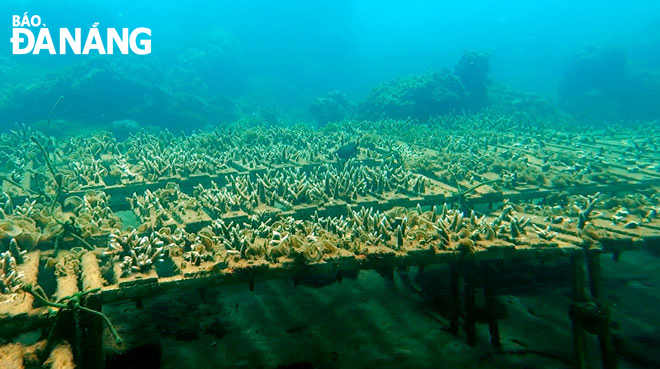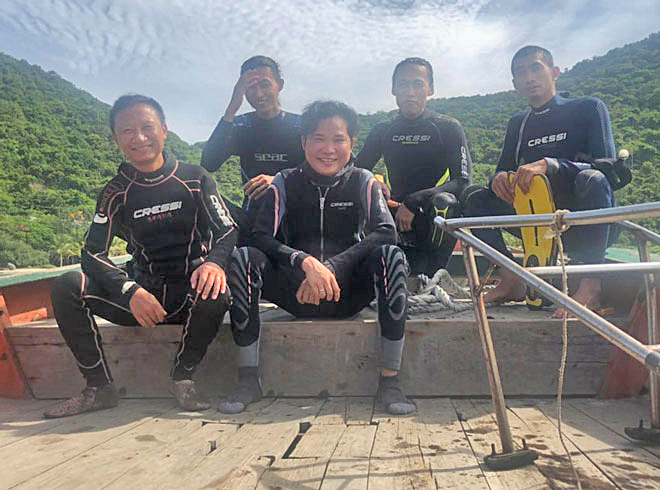Recreating the 'house' of sea
"We always do our best and get out teeth into the protection of the sea with the choice to live life to the fullest”, passionately said Mr. Le Chien while being busy with projects to regenerate coral reefs on the bottom of Son Tra waters and restore Ipomoea pes-caprae on the sand of the Central Coast.
 |
| The nursery of coral seedlings in Bai But, Son Tra is created by Sasa. Photo: D.H.L |
The coral reef ecosystem is likened to the “house” of the sea. Covering only about 1% of the sea surface, they are home to 25-40% of marine species. Currently, the coral area in Son Tra is only a hundredth as compared to the 80s and 90s, so the regeneration of coral reefs here becomes even more urgent for theSasa Marine Life Rescue Centre founded by Mr. Le Chien.
Restoring dead coral reefs
In 2009, when collaborating with leading experts on coral reefs and marine habitat restoration, Mr. Le Chien, a resident from Man Thai Ward, Son Tra District from Ha Noi decided to choose Da Nang to start his strong commitment to marine conservation.
Over 20 years of ocean science research, he has grasped an insight into an alarming situation of severely-damaged coral reefs off the Son Tra Peninsula so that he mapped out regeneration and replication plans.
This is the most sustainable way to preserve the magic of the sea because corals are not only the habitat of marine life, but also the most productive medicinal and ecological ‘warehouses that determine the sustainable fisheries.
With his strong enthusiasm, Chien is supported by many young people at home and abroad, including 6 members from the Sasa centre. Mr. Cao Dang Huy said: “When I first entered Sasa, I did not know how to swim, so I only did work on the shore. In 2021, I officially joined the coral regeneration group. “Working under the sea is very attractive to me. At first, I intended to spend only one summer on this job, but when I started working, I realized the importance of the work I do and I have stayed until now.", Nguyen Chi Dung, a member of Sasa, affirmed.
On average, each day the members work 6-8 hours underwater at a depth of 8-10m to clean the reef and regenerate damaged ones. The work requires meticulous work to pick up broken pieces of healthy coral in the deep sea, nurture it in nurseries and plant it on dead reefs. To transplant a coral branch costs VND250,000 /branch and costs tens of billions of VND to cover 100m2.
It takes decades for a coral branch to grow 10 - 20cm high, but tourists’ scuba diving or boat anchoring can also break many coral branches, ruining many years of its development.
Through Sasa's survey, all staghorn corals at the Bai But disappeared on an area of about 45,000m2. The entire bottom floor is covered with broken coral bones. This is the human impact due to construction and tourism activities, as well as storms.
In order to recover, in the immediate future, Sasa plans to recreate the nursery of coral seedlings in the Son Tra waters. From this nursery, it is possible to regenerate natural reefs and develop artificial reefs, thereby exploiting tourism and implementing educational programmes, or further, field research for professionals.
After a few months of calling for the second phase, Sasa received more than VND 105 million in contributions from the community to deploy 18 fixed nursing tables for nurseries. Sasa also contributed an additional VND 40 million from its bidget to bring the total number to 26 in the second phase.
“Our job is to take bone samples for analysis, which is very important yet complicated. One day, Sasa took on the challenge of planting 1,000 coral branches in the reef in just 2 hours. This speed is rarely achieved anywhere in the world.”, said Chien.
To pin the bar system to the bottom of the sea firmly, Sasa designed a weight kit system with more than 1 tonne in weight. The nursing tables are connected to each other by means of hard and soft connection to eliminate the frequency of shaking during storms.
Under this project, Sasa received the guidance of Dr. John Charlie Veron, who discovered and identified more than 20% of corals in the ocean, and studied the characteristics, morphology and ecology of 831 reef-forming coral species all over the world.
 |
| Ipomoea pes-caprae is seen sprouting. Photo: D.H.L |
Up to now, Sasa has completed the nursery of coral seedlings with 62 nursing tables after public appeals for financial donations. Among them are 32 extremely important reef-forming coral species such as Acropora, Montipora, Favia, Favites, Poritest, Goniopora, Alveopora , Pocilliopora, Padabacia, Turbinaria and Pavona.
“This is the only incubator in the world that is built by the whole community. The coral is growing very well and starting to branch out. From here, coral reefs in Son Tra are not only a anti-wave shield to protect the mainland, but also become heritage for the next generation to study, research and preserve rare genetic resources”, said Chien.
800km of Central Coast being green-covered
After have witnessed the sandy beach along the coast being eroded through storms, Sasa researched ways to preserve the beach according to nature and found that Ipomoea pes-caprae, a common plant species growing along the seashore, is an important factor to protect the embankment.
“Through the survey, we found that the coverage density of Ipomoea pes-caprae on the beach from Da Nang to Quang Nam is less than 1%. Regenerating this species is the cheapest method to prevent onshore erosion and help stabilize the underwater continental shelf. It also absorbs CO2, give O2 and store organic carbon. This is the foundation of life. The absorption of sunlight and conversion to O2 of this species also helps the sand become cooler”, said Chien.
Sasa will start implementing the ‘Bright morning’ campaign to cover 800km of coastline from Quang Binh to Ninh Thuan provinces with Ipomoea pes-caprae after the upcoming Tet in 4 months. The campaign is our unprecedented large environmental regeneration campaign and needs the cooperation and contributions by even more volunteers.
Ipomoea pes-caprae can retain moisture for the sand along with its interwoven root layer, up to 2m deep, which will help billions of small sand grains to bind into a block to stabilize the sand. When the sand on the shore is stable, so is the sand under the water. Since then, safe beaches have been formed, the water is also clearer, which is more convenient for tourism activities.
 |
| Sasa members relax after a hard day at the bottom of Son Tra sea. Photo courtesy of Sasa team. |
To effectively implement this campaign, Sasa has carried out a trial of 3,000 seeds and after nearly a month shoots germinated. The campaign contributes to the regeneration of biological barriers.
“We only regenerate areas that used to be and now no longer exist. The cultivation must be based on scientific reports, compared with historical data as well as soil analysis. Afew years ago, the preservation of Ipomoea pes-caprae along An Bang beach in Hoi An proved highly effective in terms of tourism and ecological roles. The green colour of Ipomoea pes-caprae, together with millions of purple flowers, will bring radiant beauty in the morning light”, said Chien.
| In 2023, Sasa will regenerate coral reefs in Hon Sup on an area of about 60,000m2 at an estimated VND30-40 billion. This nursery will be a place for tourism exploitation, aiming to prompt visitors to protect other natural coral reefs.
Sasa will call for about 10,000 volunteers who are good divers in the world to join hands in supporting the construction of coral nurseries. These people will be a potential source of visitors for the city when they return here every year to witness how their regenerated coral reefs develop. |
|
"In the face of the decline in coral resources in some provinces and cities, the Management Board of Son Tra Peninsula and Da Nang tourist beaches has strengthened support for more coral preservation. In particular, the Sasa team is the organization that has accompanied the Management Board through activities like the protection of corals off Son Tra’. In particular, the Coral Rescue Squad is expected to make its debut in April 2023. With the project of growing Ipomoea pes-caprae, the Management Board is very supportive of Sasa because it will contribute to creating green space for the beach and prevent sand flying that affects the coastal urban environment”, said Mr. Phan Minh Hai, Deputy Head of the Management Board of Son Tra Peninsula and Da Nang tourist beaches. |
Reporting by DOAN HAO LUONG - Translating by A.THU








